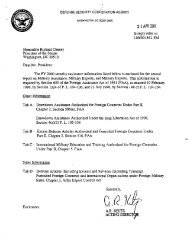memorandum of justification concerning human ... - Just the Facts
memorandum of justification concerning human ... - Just the Facts
memorandum of justification concerning human ... - Just the Facts
You also want an ePaper? Increase the reach of your titles
YUMPU automatically turns print PDFs into web optimized ePapers that Google loves.
UNCLASSIFIED<br />
- 62 -<br />
malnourishment, gastrointestinal diseases and tuberculosis. Ano<strong>the</strong>r five children from<br />
this community had already died during <strong>the</strong> preceeding weeks from similar<br />
circumstances. On July 16, 2008, ano<strong>the</strong>r 14 infants and 16 adults were transported to<br />
Quibdó for medical assistance.<br />
Government Outreach to Indigenous Groups<br />
The Colombian government continued to implement <strong>the</strong> ―Integrated Plan to<br />
Support Indigenous Communities with High Vulnerability and Risk for Disappearance,‖<br />
which was approved by <strong>the</strong> National Council for Integrated Attention to Displaced<br />
Populations on June 13, 2006. The plan identifies institutional actions needed by all<br />
levels <strong>of</strong> government to attend to <strong>the</strong> grave situation facing <strong>the</strong>se populations. During <strong>the</strong><br />
certification period, <strong>the</strong> Colombian government developed two new action plans, one<br />
focused on helping <strong>the</strong> indigenous communities on <strong>the</strong> Paujil Reservation in <strong>the</strong> Iníurida<br />
municipality <strong>of</strong> <strong>the</strong> department <strong>of</strong> Guainía (<strong>the</strong> Puinaves, Piapocos, Sikuanis, and<br />
Curripacos); and one focused on helping <strong>the</strong> Amorua community in <strong>the</strong> Department <strong>of</strong><br />
Vichada. The Colombian government also continued work on <strong>the</strong> 11 action plans<br />
developed during 2007, which focus on assisting groups in Arauca, Valle, Casanare,<br />
César, Risaralda, Guaviare, Córdoba, Guajira, and Chocó. In Arauca, for example,<br />
through <strong>the</strong> Municipal Committee for <strong>the</strong> Displaced in Arauca, <strong>the</strong> government<br />
performed a participatory assessment <strong>of</strong> <strong>the</strong> Jitnu community.<br />
The Colombian government also continued its outreach to indigenous communities<br />
identified as ―high-risk‖ through its ―Projects for Communities at Risk‖ program. Since<br />
2004, with support from <strong>the</strong> U.S. Agency for International Development (USAID), <strong>the</strong><br />
government has worked with 43 communities at risk, <strong>of</strong> which 11 are indigenous, to<br />
develop action plans to improve <strong>the</strong> security <strong>of</strong> <strong>the</strong>se communities, particularly with<br />
regard to protection <strong>of</strong> life and liberty. The beneficiary indigenous communities for this<br />
program are located in Tolima, Urabá, <strong>the</strong> Eje Cafetero, Córdoba, and Bajo Putumayo.<br />
In each <strong>of</strong> <strong>the</strong>se communities, a risk evaluation diagnostic has been conducted that<br />
describes <strong>the</strong> specific threats faced due to <strong>the</strong> armed conflict, <strong>the</strong> vulnerabilities <strong>of</strong> each<br />
community, and strategies for addressing <strong>the</strong>m. The program also developed action plans<br />
for coordinating with municipal authorities to mitigate risks faced by each community.<br />
The Colombian government continued <strong>the</strong> disbursement and implementation <strong>of</strong> <strong>the</strong><br />
―Guidelines on Attention to Indigenous Populations with a Differential Focus,‖ through<br />
meetings <strong>of</strong> representatives <strong>of</strong> <strong>the</strong> National System for Attention to and <strong>the</strong> Prevention <strong>of</strong><br />
Displacement (SNAIPD), both at <strong>the</strong> regional and national level, from <strong>the</strong> Department <strong>of</strong><br />
Santander, Antioquia, Putumayo, Bogotá, Cundinamarca, Chocó, Nariño, Arauca,<br />
Caquetá, as well as NGO representatives and regional-level organizations. These<br />
representatives developed Departmental Unique Integral Plans (PIUs) focused on ethnic<br />
UNCLASSIFIED



